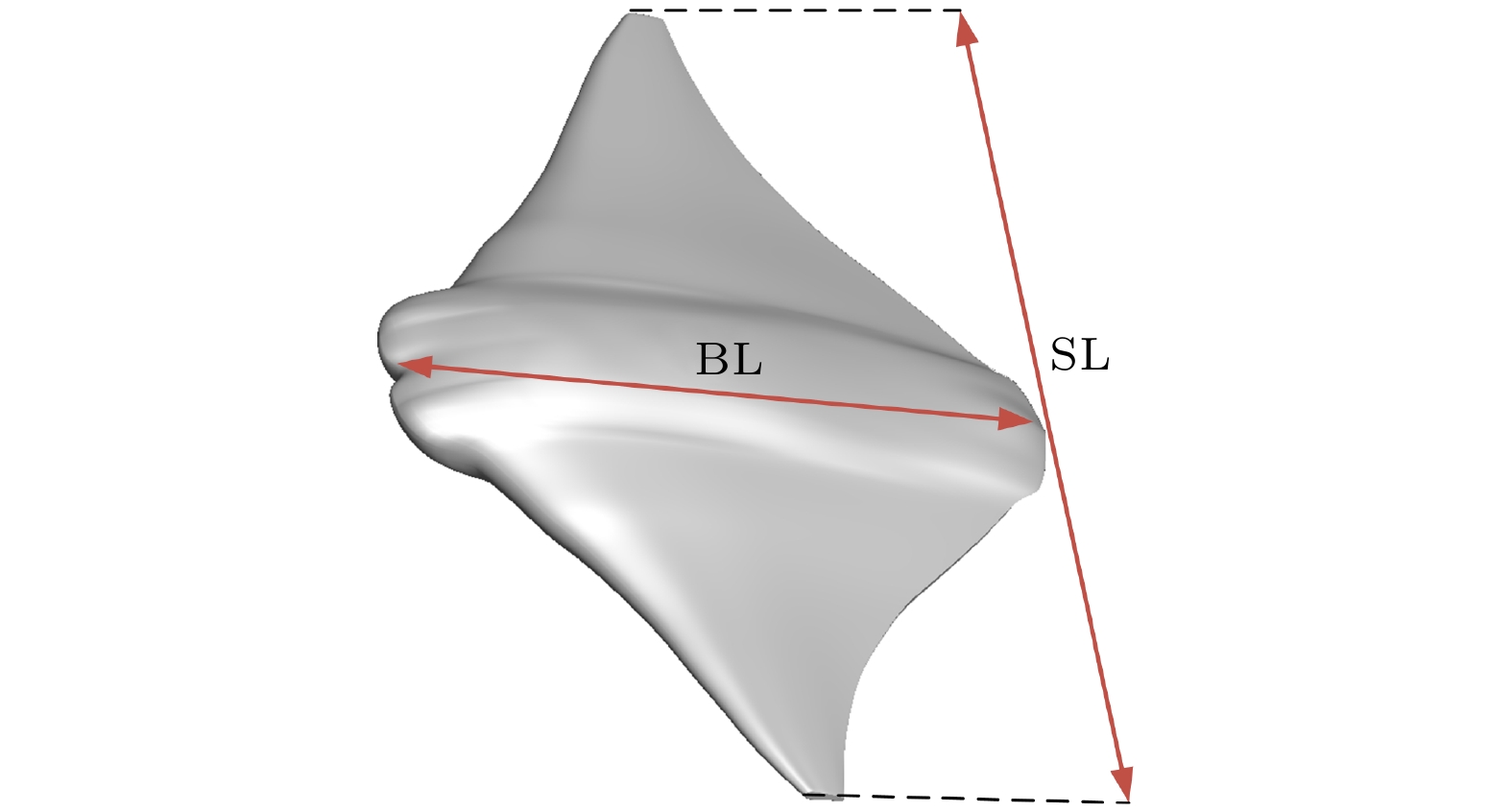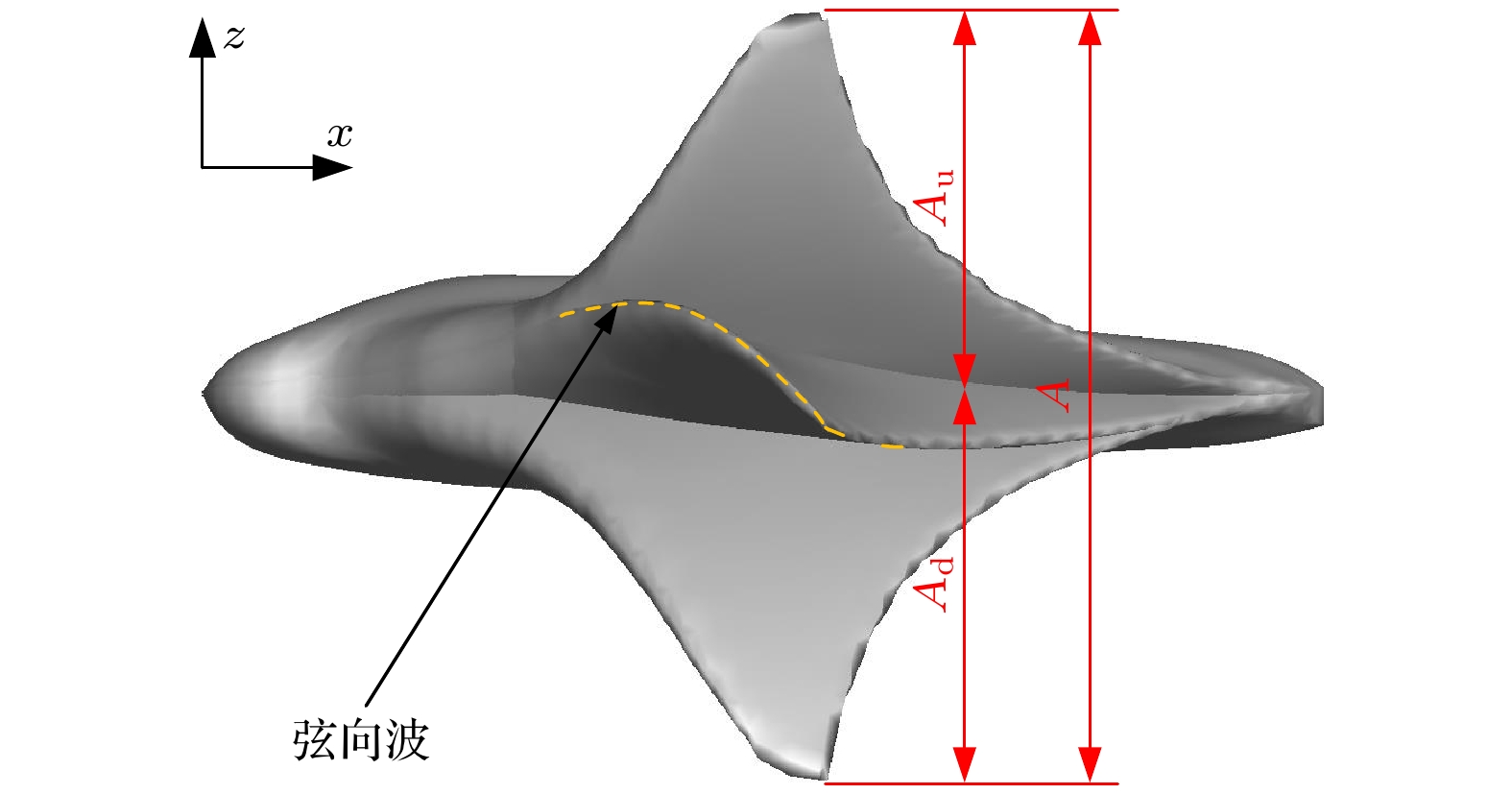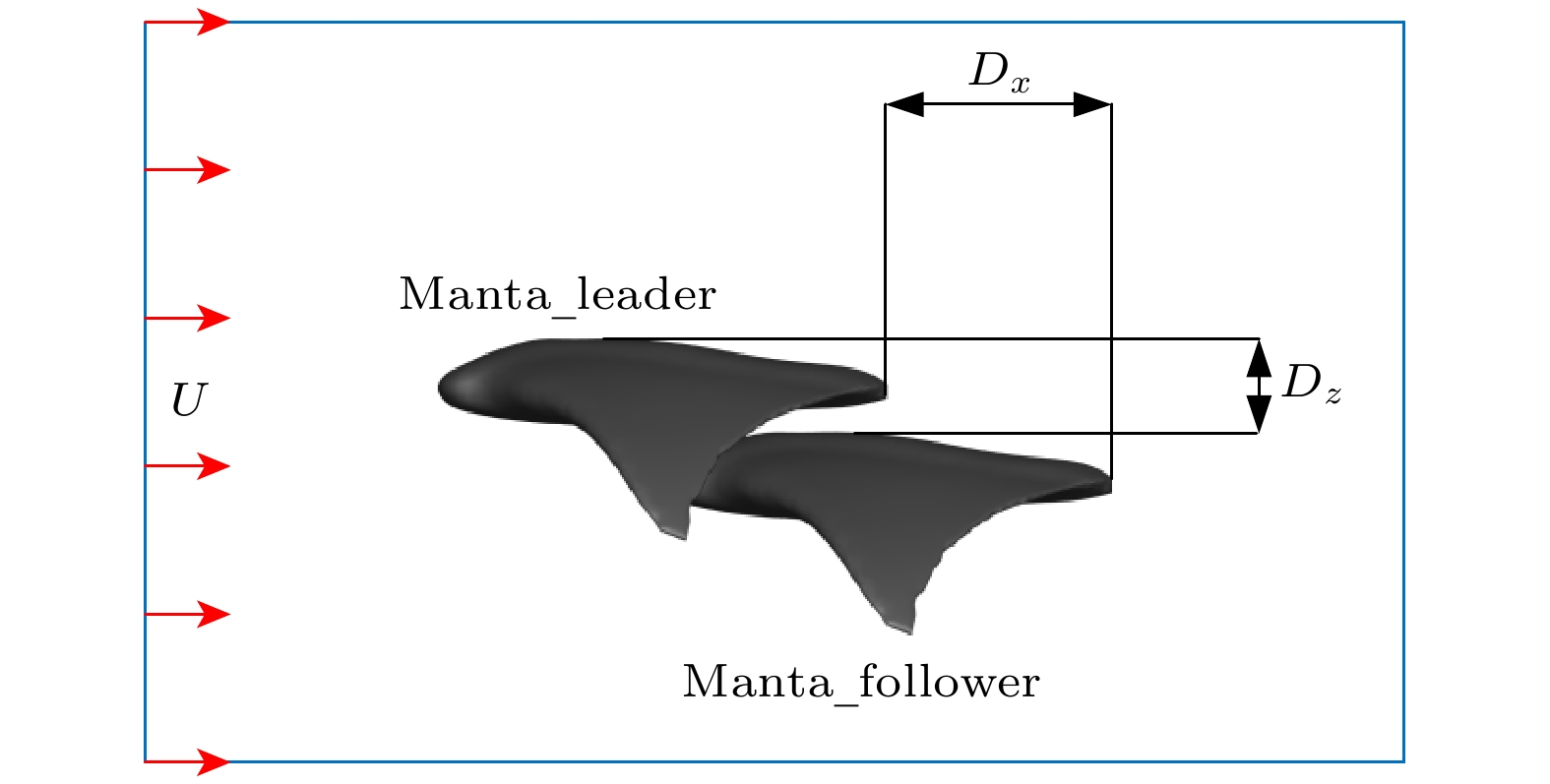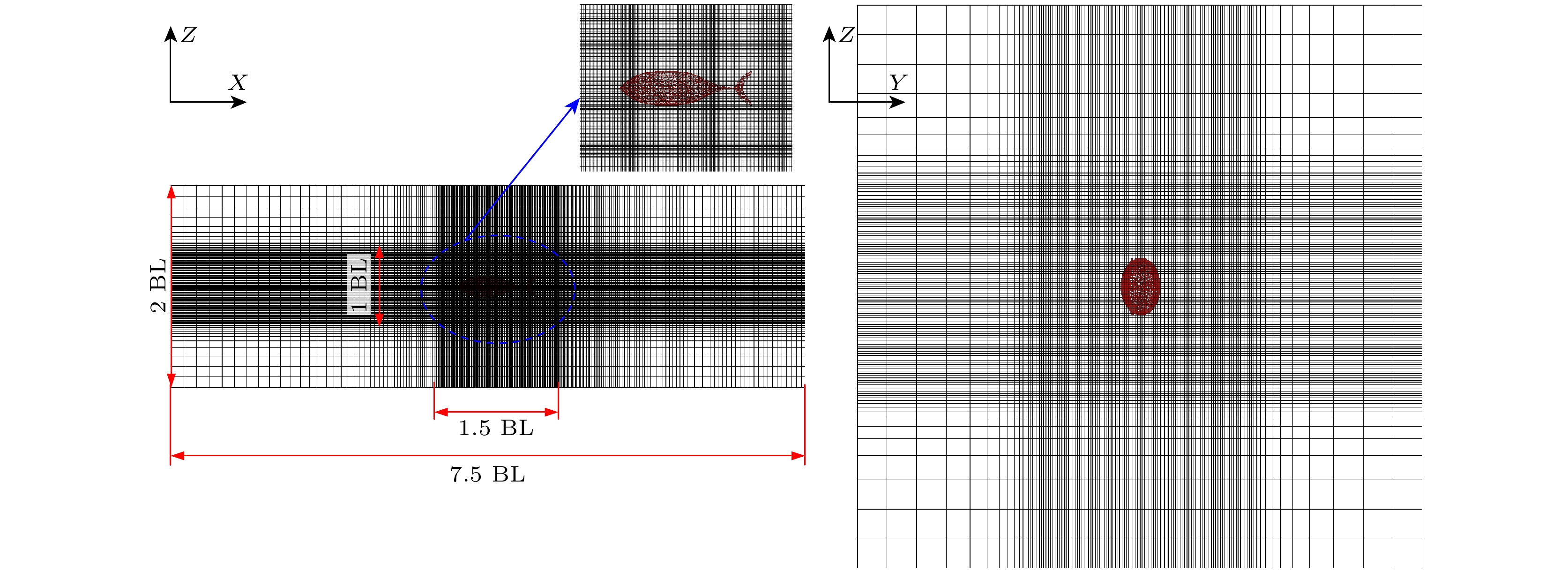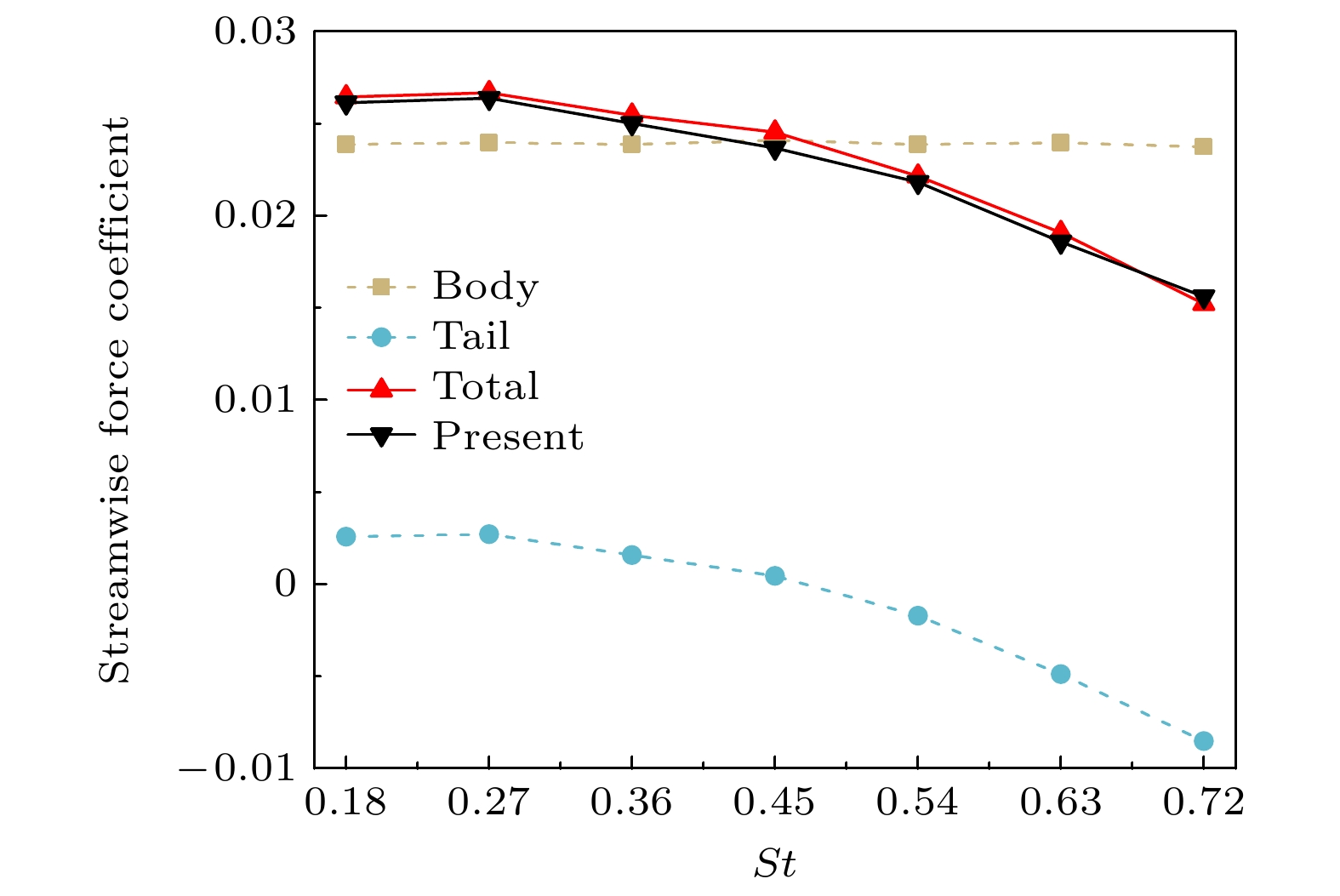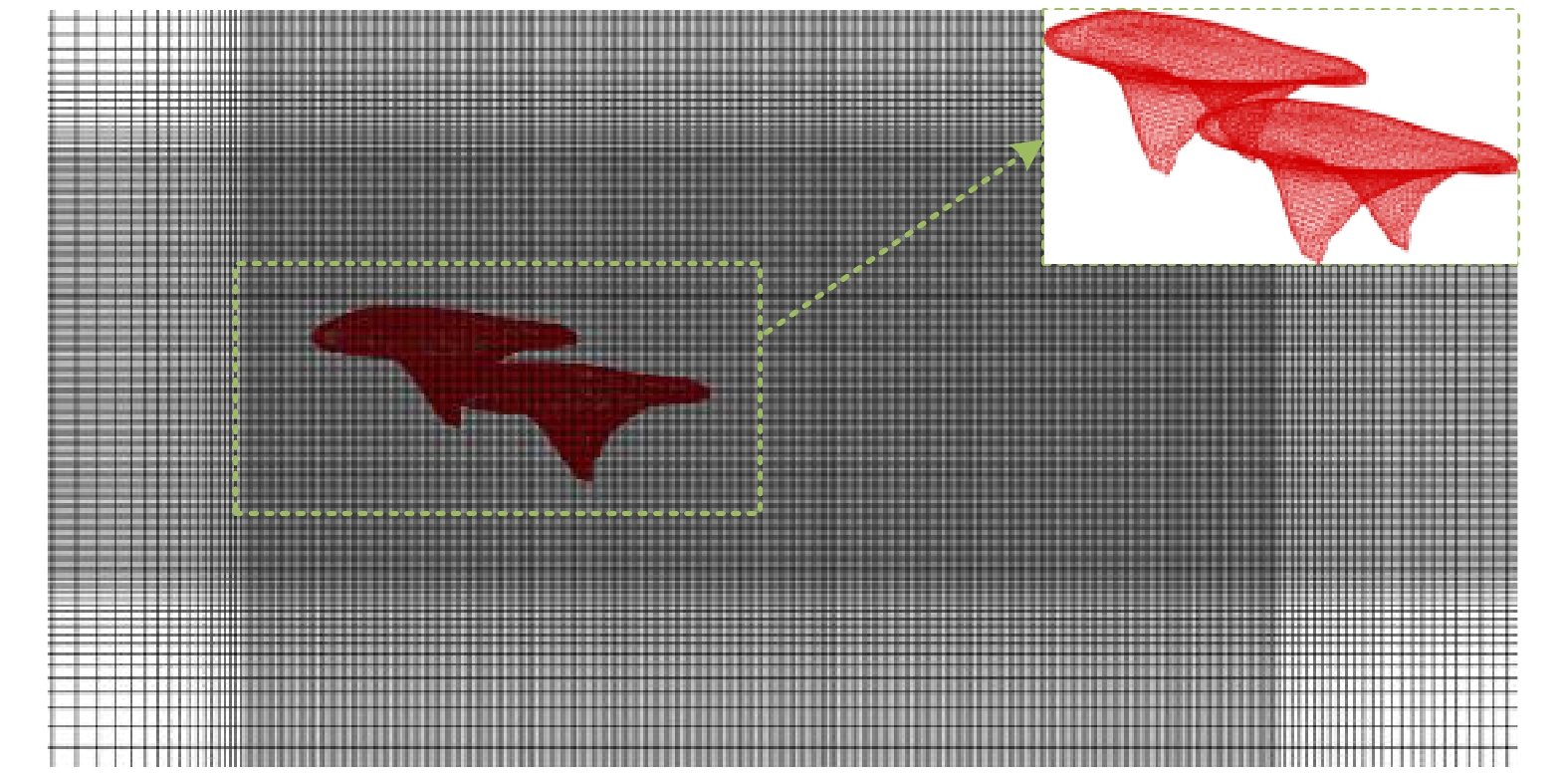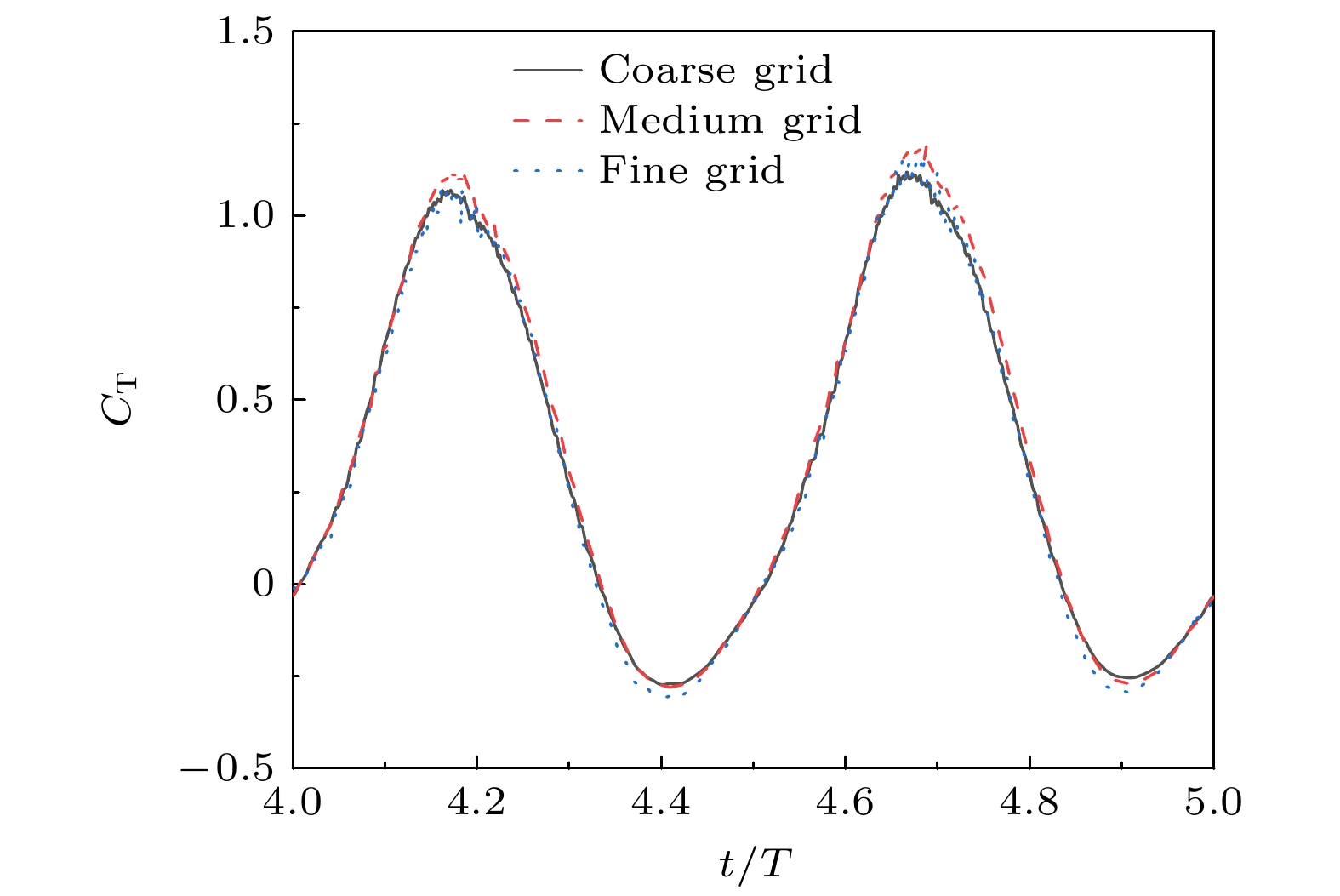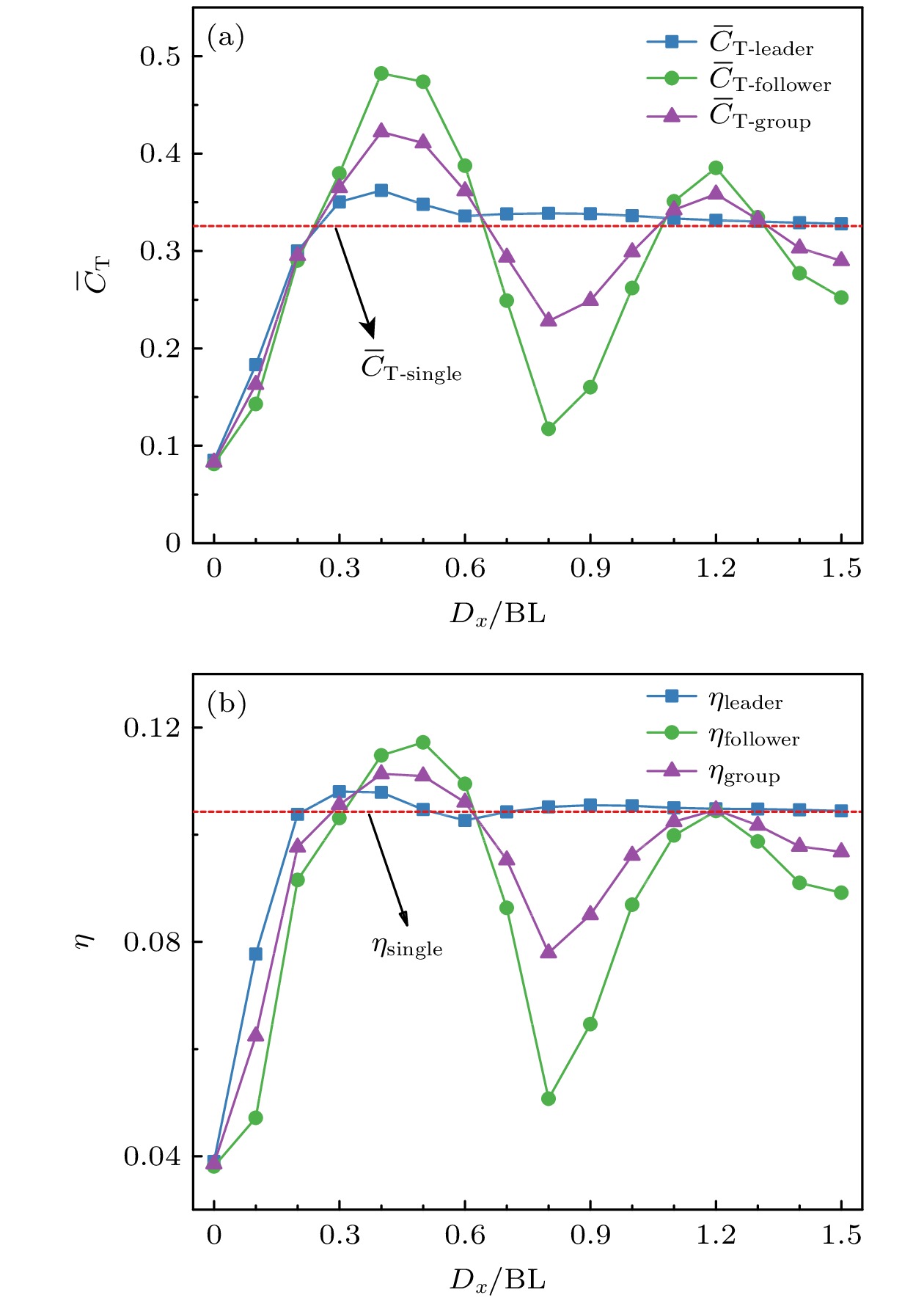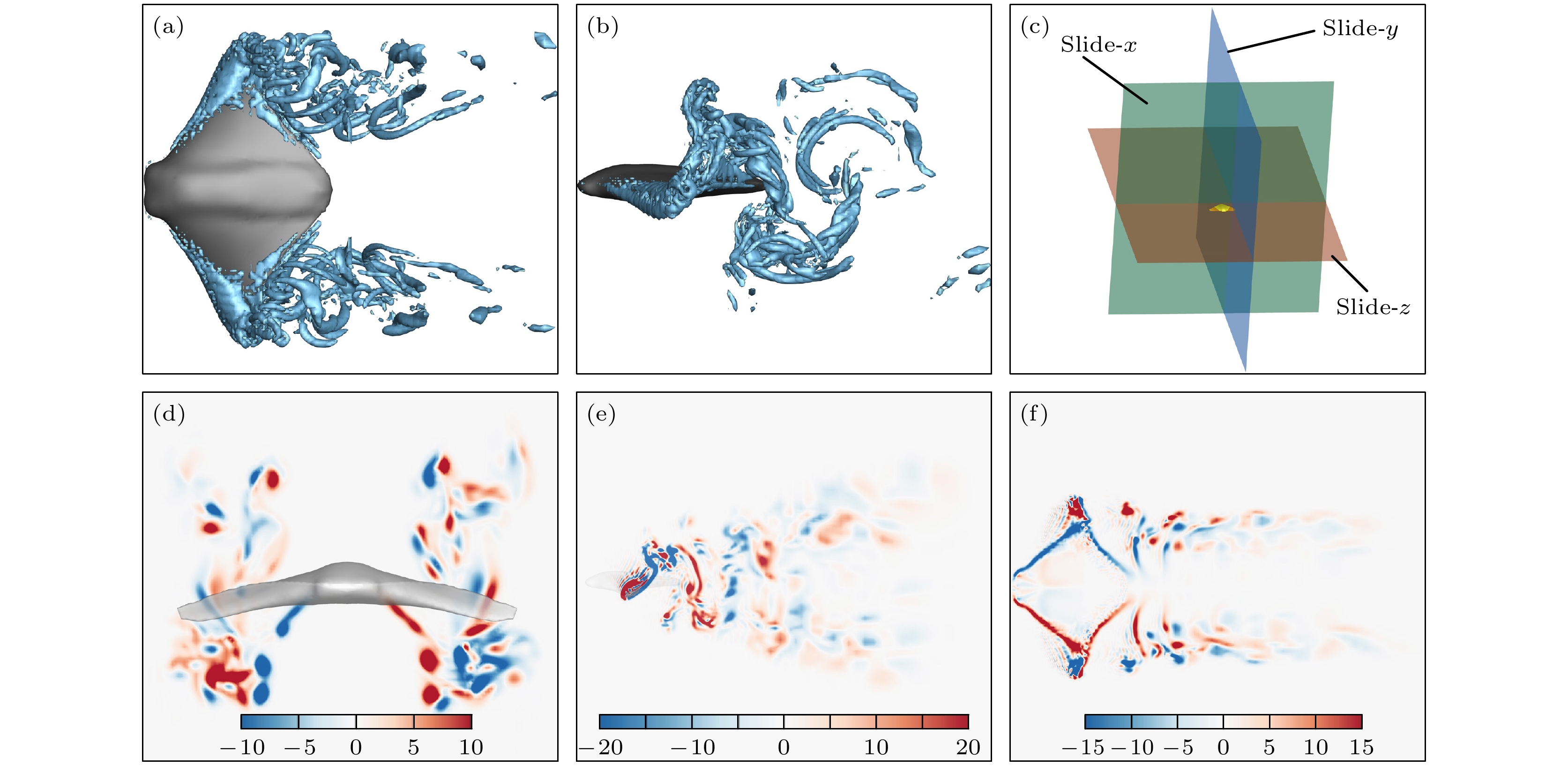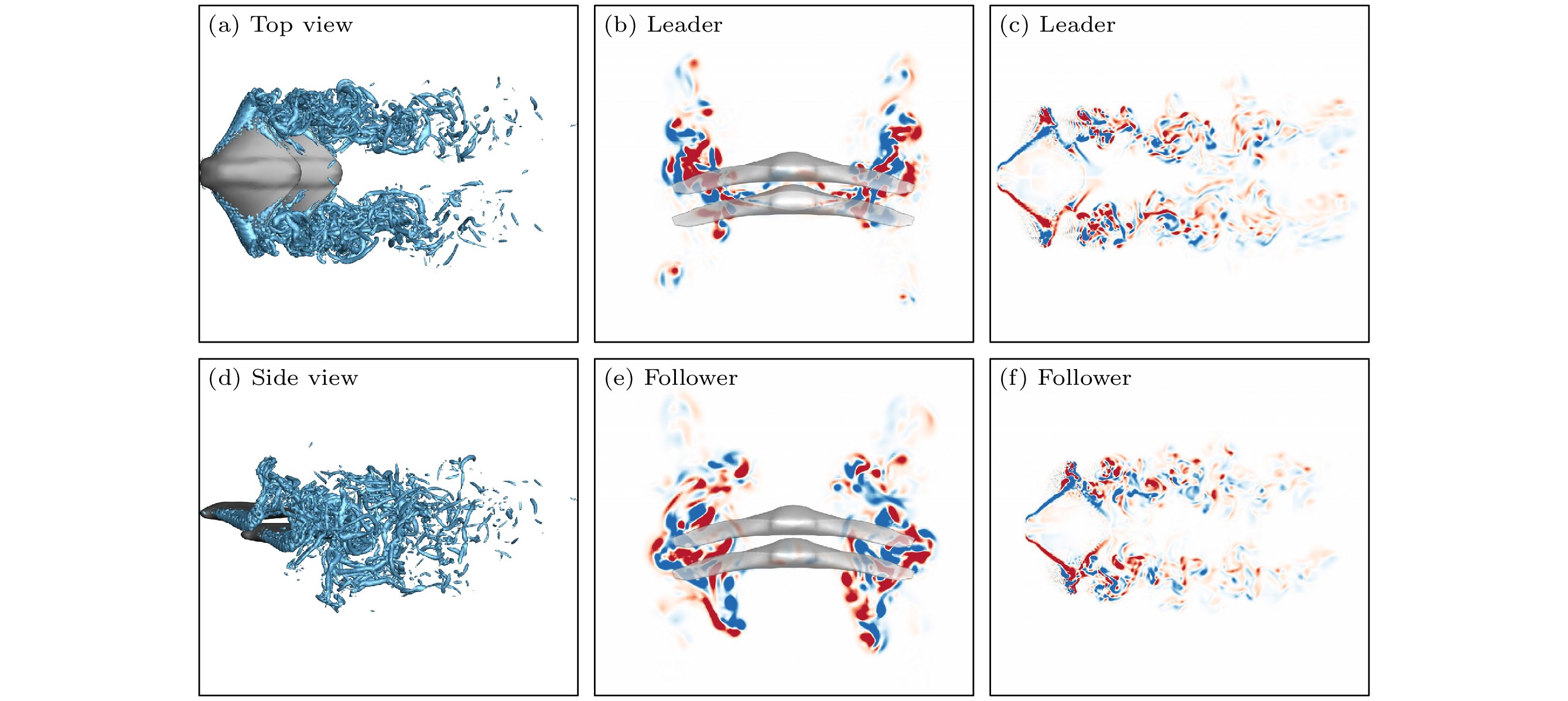-
为了探究蝠鲼“前上后下”交错排布集群游动时的水动力性能, 首先根据生物观测建立了蝠鲼形态学及运动学模型, 然后基于浸入边界法和球函数气体动理学格式(IB-SGKS)建立了鱼类集群游动数值计算方法. 系统研究了垂直间距固定为0.1倍体厚, 流向间距0—1.5倍体长(BL)下的双蝠鲼集群游动过程, 并结合全局三维涡结构和特征截面二维涡结构对集群系统以及集群中各单体的平均推力/效率进行分析. 数值结果表明: 当单体间流向间距较小时, 相比于单独游动, 推进性能急剧下降; 随着流向间距增加, 领航蝠鲼推进性能基本同单体游动保持一致; 但当Dx = 0.4BL时由于领航蝠鲼尾涡恰好越过跟随蝠鲼前缘直接作用在跟随蝠鲼初始脱落鳍尖涡处, 大幅提升其旋涡能量, 因此此时系统平均推力和效率提升均最大, 分别为29.69%和6.77%.To investigate the hydrodynamic performance of manta rays swimming in staggered arranged group, a morphological and kinematic model of manta rays is developed based on biological observations, and then a numerical calculation method is established for group swimming of manta rays based on the Immersed Boundary Method and the Sphere function-based Gas Kinetic Scheme (IB-SGKS). The group swimming of two manta rays with a fixed vertical spacing of 0.1 times the body thickness, and a flow direction spacing of 0—1.5 times the body length is systematically investigated. The average thrust/efficiency of the group system and each individual in the group are analyzed by combining the global three-dimensional (3D) vortex structure and the characteristic cross-section two-dimensional (2D) vortex structure. The numerical results are shown below. When the streamwise spacing between individuals is small, the propulsive performance decreases sharply compared with swimming alone; as the streamwise spacing increases, the propulsive performance of the leader manta ray is consistently better than that of swimming alone, with the maximum thrust enhanced up to 11.24% when Dx = 0.4BL, and the maximum efficiency is enhanced up to 3.58% when Dx = 0.3BL; with the increase of the streamwise spacing, in the thrust/efficiency curves of the follower manta ray appears volatility, with the maximum thrust enhanced to 48.14% when Dx = 0.4BL and the maximum efficiency reached to 12.39% when Dx = 0.5BL; the system average thrust and efficiency enhancement both reach their corresponding maximum values, specifically, 29.69% and 6.77%, when Dx = 0.4BL, which is because the tail vortex of the leading manta ray just passes through the front edge of the follower manta ray and directly acts on the tip vortex that initially falls off from the follower manta rays, thus substantially increasing their vortex energy.
-
Keywords:
- manta rays /
- group swimming /
- staggered arrangement /
- hydrodynamic performance /
- vortex structure
[1] Walker J A, Westneat M W 1997 J. Exp. Biol. 200 1549
 Google Scholar
Google Scholar
[2] Borazjani I, Sotiropoulos F, Tytell E D, Lauder G V 2012 J. Exp. Biol. 215 671
 Google Scholar
Google Scholar
[3] Wöhl S, Schuster S 2007 J. Exp. Biol. 210 311
 Google Scholar
Google Scholar
[4] Li L, Ravi S, Xie G, Couzin I D 2021 Proc. R. Soc. A-Math. Phys. Eng. Sci. 477 20200810
 Google Scholar
Google Scholar
[5] Weihs D 1973 Nature 241 290
 Google Scholar
Google Scholar
[6] Chen S Y, Fei Y H J, Chen Y C, Chi K J, Yang J T 2016 Ocean Eng. 122 22
 Google Scholar
Google Scholar
[7] Wei C, Hu Q, Li S J, Shi X D 2023 Ocean Eng. 267 113258
 Google Scholar
Google Scholar
[8] Tian F B, Luo H, Zhu L, Liao J C, Lu X Y 2011 J. Comput. Phys. 230 7266
 Google Scholar
Google Scholar
[9] Tian F B, Wang W, Wu J, Sui Y 2016 Comput. Fluids 124 1
 Google Scholar
Google Scholar
[10] Li Y F, Chang J T, Kong C, Bao W 2022 Chin. J. Aeronaut. 35 14
 Google Scholar
Google Scholar
[11] 王亮 2007 博士学位论文 (南京: 河海大学)
Wang L 2007 Ph. D. Dissertation (Nanjing: Hehai University
[12] Jian D, Shao X M 2006 J. Hydrodyn. 18 438
 Google Scholar
Google Scholar
[13] Chung M H 2011 J. Mech. 27 177
 Google Scholar
Google Scholar
[14] Dai L Z, He G W, Zhang X, Zhang X 2018 J. R. Soc. Interface 15 20180490
 Google Scholar
Google Scholar
[15] Chao L M, Zhang D, Cao Y H, Pan G 2018 Mod. Phys. Lett. B 32 1850034
 Google Scholar
Google Scholar
[16] Chao L M, Pan G, Zhang D, Yan G X 2019 Ocean Eng. 183 167
 Google Scholar
Google Scholar
[17] Li X H, Gu J Y, Su Z, Yao Z Q 2021 Phys. Fluids 33 121905
 Google Scholar
Google Scholar
[18] 高鹏骋, 刘冠杉, 黄桥高, 潘光, 马云龙 2023 力学学报 55 62
 Google Scholar
Google Scholar
Gao P C, Liu G S, Huang Q G, Pan G, Ma Y L 2023 Chin. J. Theor. Appl. Mech. 55 62
 Google Scholar
Google Scholar
[19] 高鹏骋, 黄桥高, 宋东, 潘光, 马云龙 2023 西北工业大学学报 41 595
 Google Scholar
Google Scholar
Gao P C, Huang Q G, Song D, Pan G, Ma Y L 2023 Journal of Northwestern Polytechnical University 41 595
 Google Scholar
Google Scholar
[20] Gao P C, Huang Q G, Pan G, Ma Y L, Song D 2022 Phys. Fluids 34 111908
 Google Scholar
Google Scholar
[21] Gao P C, Huang Q G, Pan G, Cao Y, Luo Y 2023 Ocean Eng. 278 114389
 Google Scholar
Google Scholar
[22] Gao P C, Huang Q G, Pan G, Song D, Cao Y 2023 Phys. Fluids 35 061909
 Google Scholar
Google Scholar
[23] 张栋 2020 博士学位论文 (西安: 西北工业大学)
Zhang D 2020 Ph. D. Dissertation (Xi’an: Northwestern Polytechnical University
[24] Zhang D, Huang Q G, Pan G, Yang L M, Huang W X 2022 J. Fluid Mech. 930 A28
 Google Scholar
Google Scholar
[25] Zhang D, Huang W X 2023 J. Fluid Mech. 963 A16
 Google Scholar
Google Scholar
[26] Taira K, Colonius T 2007 J. Comput. Phys. 225 2118
 Google Scholar
Google Scholar
[27] Yang L M, Shu C, Wu J 2015 J. Comput. Phys. 295 322
 Google Scholar
Google Scholar
[28] Yang L M, Shu C, Wang Y, Sun Y 2016 J. Comput. Phys. 319 129
 Google Scholar
Google Scholar
[29] Yang L M, Shu C, Yang W M, Wang Y, Wu J 2017 Phys. Fluids 29 083605
 Google Scholar
Google Scholar
[30] Zhang J D, Sung H J, Huang W X 2020 Phys. Fluids 32 111902
 Google Scholar
Google Scholar
[31] Han P, Pan Y, Liu G, Dong H B 2022 J. Fluids Struct. 108 103422
 Google Scholar
Google Scholar
[32] Gao P C, Tian X S, Huang Q G, Pan G 2024 Phys. Fluids 36 0180621
 Google Scholar
Google Scholar
-
-
[1] Walker J A, Westneat M W 1997 J. Exp. Biol. 200 1549
 Google Scholar
Google Scholar
[2] Borazjani I, Sotiropoulos F, Tytell E D, Lauder G V 2012 J. Exp. Biol. 215 671
 Google Scholar
Google Scholar
[3] Wöhl S, Schuster S 2007 J. Exp. Biol. 210 311
 Google Scholar
Google Scholar
[4] Li L, Ravi S, Xie G, Couzin I D 2021 Proc. R. Soc. A-Math. Phys. Eng. Sci. 477 20200810
 Google Scholar
Google Scholar
[5] Weihs D 1973 Nature 241 290
 Google Scholar
Google Scholar
[6] Chen S Y, Fei Y H J, Chen Y C, Chi K J, Yang J T 2016 Ocean Eng. 122 22
 Google Scholar
Google Scholar
[7] Wei C, Hu Q, Li S J, Shi X D 2023 Ocean Eng. 267 113258
 Google Scholar
Google Scholar
[8] Tian F B, Luo H, Zhu L, Liao J C, Lu X Y 2011 J. Comput. Phys. 230 7266
 Google Scholar
Google Scholar
[9] Tian F B, Wang W, Wu J, Sui Y 2016 Comput. Fluids 124 1
 Google Scholar
Google Scholar
[10] Li Y F, Chang J T, Kong C, Bao W 2022 Chin. J. Aeronaut. 35 14
 Google Scholar
Google Scholar
[11] 王亮 2007 博士学位论文 (南京: 河海大学)
Wang L 2007 Ph. D. Dissertation (Nanjing: Hehai University
[12] Jian D, Shao X M 2006 J. Hydrodyn. 18 438
 Google Scholar
Google Scholar
[13] Chung M H 2011 J. Mech. 27 177
 Google Scholar
Google Scholar
[14] Dai L Z, He G W, Zhang X, Zhang X 2018 J. R. Soc. Interface 15 20180490
 Google Scholar
Google Scholar
[15] Chao L M, Zhang D, Cao Y H, Pan G 2018 Mod. Phys. Lett. B 32 1850034
 Google Scholar
Google Scholar
[16] Chao L M, Pan G, Zhang D, Yan G X 2019 Ocean Eng. 183 167
 Google Scholar
Google Scholar
[17] Li X H, Gu J Y, Su Z, Yao Z Q 2021 Phys. Fluids 33 121905
 Google Scholar
Google Scholar
[18] 高鹏骋, 刘冠杉, 黄桥高, 潘光, 马云龙 2023 力学学报 55 62
 Google Scholar
Google Scholar
Gao P C, Liu G S, Huang Q G, Pan G, Ma Y L 2023 Chin. J. Theor. Appl. Mech. 55 62
 Google Scholar
Google Scholar
[19] 高鹏骋, 黄桥高, 宋东, 潘光, 马云龙 2023 西北工业大学学报 41 595
 Google Scholar
Google Scholar
Gao P C, Huang Q G, Song D, Pan G, Ma Y L 2023 Journal of Northwestern Polytechnical University 41 595
 Google Scholar
Google Scholar
[20] Gao P C, Huang Q G, Pan G, Ma Y L, Song D 2022 Phys. Fluids 34 111908
 Google Scholar
Google Scholar
[21] Gao P C, Huang Q G, Pan G, Cao Y, Luo Y 2023 Ocean Eng. 278 114389
 Google Scholar
Google Scholar
[22] Gao P C, Huang Q G, Pan G, Song D, Cao Y 2023 Phys. Fluids 35 061909
 Google Scholar
Google Scholar
[23] 张栋 2020 博士学位论文 (西安: 西北工业大学)
Zhang D 2020 Ph. D. Dissertation (Xi’an: Northwestern Polytechnical University
[24] Zhang D, Huang Q G, Pan G, Yang L M, Huang W X 2022 J. Fluid Mech. 930 A28
 Google Scholar
Google Scholar
[25] Zhang D, Huang W X 2023 J. Fluid Mech. 963 A16
 Google Scholar
Google Scholar
[26] Taira K, Colonius T 2007 J. Comput. Phys. 225 2118
 Google Scholar
Google Scholar
[27] Yang L M, Shu C, Wu J 2015 J. Comput. Phys. 295 322
 Google Scholar
Google Scholar
[28] Yang L M, Shu C, Wang Y, Sun Y 2016 J. Comput. Phys. 319 129
 Google Scholar
Google Scholar
[29] Yang L M, Shu C, Yang W M, Wang Y, Wu J 2017 Phys. Fluids 29 083605
 Google Scholar
Google Scholar
[30] Zhang J D, Sung H J, Huang W X 2020 Phys. Fluids 32 111902
 Google Scholar
Google Scholar
[31] Han P, Pan Y, Liu G, Dong H B 2022 J. Fluids Struct. 108 103422
 Google Scholar
Google Scholar
[32] Gao P C, Tian X S, Huang Q G, Pan G 2024 Phys. Fluids 36 0180621
 Google Scholar
Google Scholar
计量
- 文章访问数: 4938
- PDF下载量: 126
- 被引次数: 0













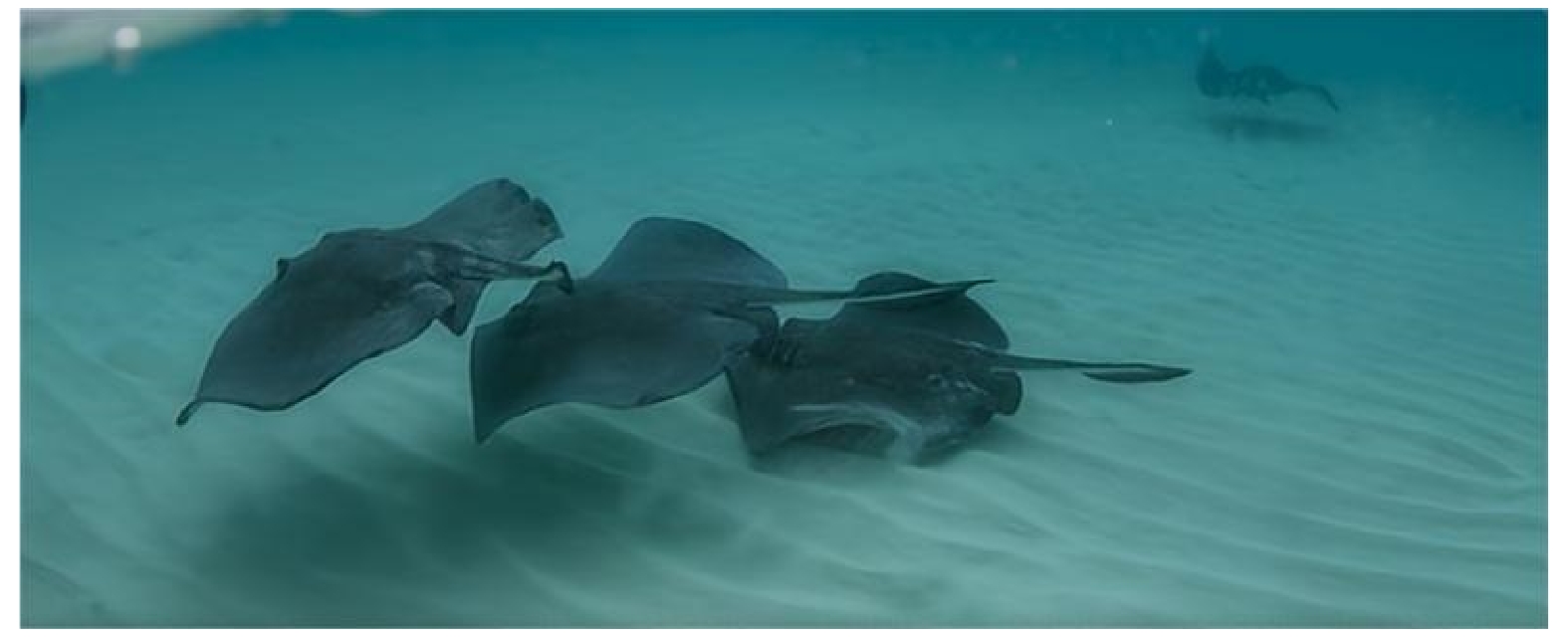
 下载:
下载:
